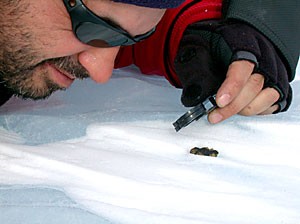A UA alumnus is following in the footsteps of many other UA-affiliated researchers as he heads to Antarctica’s icy, forbidding tundra to hunt for meteorites.
Through a program known as The Antarctic Search for Meteorites, or ANSMET, Don Pettit, a UA engineering alumnus and NASA astronaut, has been sent along with a team of seven others to help build his endurance in varying climates.
Although he is the only participant affiliated with the UA this year, Pettit is one of 10 UA staff and students who have participated in an ANSMET expedition.
Twenty years ago, Faith Vilas, an astronomer and director of the multiple mirror telescope observatory, took to the icy continent to search for meteorites.
“”Back then, we had no communication, no Internet to post pictures or blogs to,”” Vilas said. “”It was so remote that it could really throw you through a loop if you let it, but at the same time, (it) was some of the most majestic scenery that I have ever seen.””
Battling hypothermia and dehydration from the climate, Vilas said her team found 324 meteorites in eight weeks, ranging in size from little more than a few centimeters to 8 inches wide.
“”We found meteorites on foot or on snowmobiles and mapped out old and new sites,”” Vilas said. “”But this was before GPS machines.””
Tim Swindle, a professor of planetary science, has also developed a love for meteorite hunting in Antarctica and is gearing up for his third expedition, which will take place next year.
“”It’s really cold and really addictive,”” Swindle laughed as he recalled previous adventures. “”The U.S. has been doing these expeditions for about 30 years, and for the past 10 there has been someone on the team from the UA.””
The UA’s relationship with ANSMET is a result of the university’s world-renowned planetary science program, Swindle said.
“”Individuals from the UA have gone and done well, so we have connections to the program from all of these people,”” Swindle said. “”Plus, one person will go and come back so enthralled that others start to think, ‘Maybe I can do that.'””
Although meteorites fall evenly around the world, the ice fields of Antarctica provide visibility and a climate in which meteorites can be better preserved, Swindle said.
“”It’s easy to find a black rock on white ice,”” he pointed out.
Similarly, in what is called the “”conveyor belt”” effect, strong winds will erode glacier walls to expose well-preserved and uncontaminated meteorites that are more than 1,000 years old, Swindle said.
“”The ice holds so many meteorites,”” Swindle said. “”The most one group has found is over 1,000 in six weeks.””
Dante Lauretta, an associate professor of planetary sciences, was a member of that group, finding a record number of meteorites in what he described as “”a very good year.””
“”Antarctica is the best place to hunt for meteorites,”” Lauretta said. “”In this field, it’s kind of like your civic duty to go down there and help pick up meteorites, because we all benefit from it.””
In each annual expedition, there is usually one astronaut in the group who benefits from exposure to the harsh conditions that are similar to those in space, Swindle and Lauretta concluded.
This year, Pettit is that astronaut, although he is only one of two UA engineering alumni to apply his degree toward becoming an astronaut, said Jeff Goldberg, associate dean of the engineering department.
“”We don’t have a lot of people doing this kind of stuff, but our students are incredibly broad and accomplish many things,”” Goldberg said.
Part of the beauty of taking an astronaut to a place like Antarctica is seeing how others adjust to the environment, Swindle said.
“”Primarily it is researchers and graduate students who go on these trips, but astronauts are interested in how people adapt,”” Swindle said. “”It’s not always comfortable, but Antarctica is a beautiful place.””









